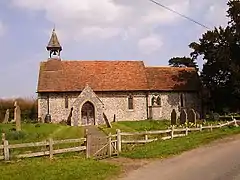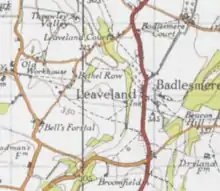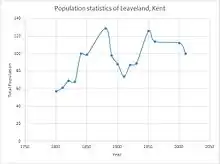Leaveland
Leaveland is a hamlet and civil parish located in the Swale borough of Kent, South East England. In terms of topography, it is described as a "village surrounded by inhabited countryside",[2] and is situated mostly on high ground.[3] It is located 5 miles South of Faversham, West of Badlesmere, and the A251.The closest train station to the area is Selling, which is 5.45 km away. The closest estuary is The Swale which separates the Isle of Sheppey from mainland Kent, and flows through Faversham.[4] Leaveland itself covers an area of 1.5 km².
| Leaveland | |
|---|---|
 St Laurence Church, Leaveland | |
 Leaveland Location within Kent | |
| Population | 100 (2011 Census)[1] |
| Civil parish |
|
| District | |
| Shire county | |
| Region | |
| Country | England |
| Sovereign state | United Kingdom |
| Post town | Faversham |
| Postcode district | ME13 |
| Police | Kent |
| Fire | Kent |
| Ambulance | South East Coast |
| UK Parliament | |
According to the 2011 Census there were 54 males and 46 females living in the parish.[5]
Leaveland as a civil parish is too small to have its own parish council, therefore Sheldwich, Badlesmere and Leaveland have a combined parish council (their total population is 759), consisting of 8 members. They have monthly meetings where by they deal with local issues, help aid council spending, and provide information to organisations who operate in the area.[6] Leaveland is also part of Swale Borough Council, as part of the 4 towns in the borough. These include Faversham, Sittingbourne, Sheerness and Queenborough. The Borough currently has 47 councillors. The conservative party holds the majority since the last election (2015) with 32.[7]
History

In the 1870s, Leaveland was described as:
A parish in Faversham district, Kent; 3¼ miles SW of Selling r. station, and 4¼ S by W of Faversham. Post town, Badlesmere, under Faversham. Acres, 372. Real property, £685. Pop., 94. Houses, 23. The property is divided among a few. The manor and much of the land belong to Lord Sondes. The living is a rectory, annexed to the rectory of Badlesmere, in the diocese of Canterbury. The church has a wooden turret, and is good.[8]
The name Leaveland comes from the Old English '"land' meaning "land, an estate", this is linked with a warlords name; so "Leofas land".[9] This is one of the main reasons for the dominance of agricultural practices which take place here.
Leaveland is mentioned in the Domesday book as "Levant", in the hundred of Faversham. There was a total population of 3 households, and 1 unchanged tax units, with 2 villagers, with 1 small holder. There is 1 lords plough team, and 1 men's plough team and other resources include a woodland 5 swine render. The overlord in 1066 was Archbishop of Canterbury, and the value of the area to the lord in 1070 was £1.5.[10]
St Laurence Church

St Laurence Church is the parish church (dedicated to Saint Laurence) and a Grade II listed building. Its described as "delightfully small, simple and still".[11] The church was built by the Normans, and was consecrated in 1222, but was restored in the 18th century with the addition of a vestry. It is located on the eastern side of the parish, with the court-lodge near. It was described by Edward Hasted in 1798 as a "small mean building, consisting of one isle and a chance, with a low pointed wooden current on it".[9]
The church combines with St Leonard's, Badlesmere, forming one parish. Both are open everyday, and frequently used for prayer by walk-ins as well as regulars. Holy Communions are held every first and third Sunday of the month. They combine to hold many occasions each year too, this includes flower festivals, chilli festivals, concerts, lunches, and outdoor activities.[12]
Demographics
Population

The population of Leaveland over the last two centuries (1801-2011) has fluctuated. For the first century the population saw a significant increase and then a drastic decrease towards the end. In 1801, the population was 57, and this was the lowest it has ever been. From this date up until 1881 the population more than doubled to 129, the highest the population has ever been. In 1911 it plummeted to 74, but by 1921 it began to increase again and by 1951 reached 126, after this, it has gradually decreased, and by 2011 reached 100.[5][13] The population now is actually less than it has been in previous decades.
Leaveland has a very small population compared to its surrounding areas. In 2011 Badlesmere had a higher population of 134,[14] and Sheldwich had more than quadruple Leaveland with 491.[15]
According to the 2011 census 11% of the population are aged 0–15, 80% are aged between 16-74, and 9% are aged 75+. The average age is 48.3 years old.[16]
Ethnicity
According to the 2011 census, the only ethnic group in Leaveland is White British.[17] 100 out of 100 people are reported to be White British. In 2001 census there was also 100% White British but with 112 people.[18]
Employment

The largest sector in employment in 1881 for males was agriculture with 22. This was the most common, as during this time the majority of men would work as labourers on the rich's land. On the other hand, the largest sector for women was "unknown" with 23. This could be because during this time women may have stayed at home to look after their children. Birth rates would have been very high because contraceptives weren't accessible, this means that families were bigger.[19] This is very different to the 2011 census where employment categories were very different. The most common sectors include Skilled Trade, which includes metal and electrical trades as well as agricultural skills (with 13 people), and Professional Occupations which involve health, science and business (with 10 people).[20] These have all changed because of economic growth and the development of new industries to make a living, not just agriculture.
Housing
The housing types in Leaveland include Detached, Semi-detached, flats and terraced housing, with the majority being owner occupied.[21] House prices can vary from low to high, but the current (2017) average value is £306,730, and this is a 4.12% increase from the previous year. This is over double of that 20 years ago where the value change was £228,036.[22] Although, this is much lower compared to surrounding villages like Badlesmere where the average house value is £784,596 and Throwley where the average value is £675,161.[23]
Education
The closest nursery and primary school is Sheldwich, located 1.5 miles away. They are an Ofsted "outstanding" school, with a combined intake of 481 children.[24] However,there are not many secondary schools near the area, the closest being Canterbury High School or The Queen Elizabeth Grammar school, which are over 10 miles away.
Health
Newton Place Pharmacy is where the population of Leaveland can access medicine, advice, and treatment for common illnesses like colds and coughs. It is located only 4.4 miles away. The closest hospital is Faversham Cottage hospital, which is 4.5 miles away, this is a rehabilitation focused inpatient hospital, with only 25 beds.[25] For accident and emergency the William Harvey Hospital in Ashford is the closest, at 7.7 miles away. Open 24 hours a day, and can deal with anything up to life threatening emergencies. This is also where people have a longer term stay for illness, or important operations.[26]
References
- "Civil Parish population 2011". Neighbourhood Statistics. Office for National Statistics. Retrieved 21 September 2016.
- Services, Good Stuff IT. "Bagshill Road, Throwley Valley, Leaveland, Kent Map and local information - the British Streets website". British Streets. Retrieved 23 March 2017.
- "Parishes: Leveland | British History Online". www.british-history.ac.uk. Retrieved 28 March 2017.
- "BBC - Nature's Calendar". www.bbc.co.uk. Retrieved 22 March 2017.
- "Leaveland (Parish): Key Figures for 2011 Census: Key Statistics". Neighbourhood Statistics. Office for National Statistics. Retrieved 28 January 2016.
- "Parish Council". Retrieved 25 April 2017.
- "Swale Borough Council". Retrieved 3 May 2017.
- Wilson, John Marius (1870–1872). "Imperial Gazetteer of England and Wales". www.visionofbritain.org.uk. A. Fullerton & Co. Retrieved 2 February 2017.
- "History of Leaveland". Retrieved 15 March 2017.
- Powell-Smith, Anna. "Leaveland [Court] | Domesday Book". opendomesday.org. Retrieved 23 March 2017.
- "St Laurence Church". Retrieved 25 April 2017.
- "St Laurence, Leaveland". Retrieved 2 May 2017.
- "Leaveland CP/AP through time -Population Statistics -Total Population". www.visionofbritain.org.uk. Retrieved 23 March 2017.
- "Key Statistics Baldesmere". Retrieved 25 April 2017.
- "Key Statistics Sheldwich". Retrieved 25 April 2017.
- Sillitoe, Neighbourhood Statistics (14 April 2008). "Employment statistics". www.neighbourhood.statistics.gov.uk. Retrieved 23 March 2017.
- "Ethnic group 2011 Leaveland". Retrieved 2 May 2017.
- "Ethnic group 2001 Leaveland". Retrieved 2 May 2017.
- "VOB Leaveland Industry". Retrieved 2 May 2017.
- "Occupational Structure 2011". March 2011. Retrieved 28 March 2017.
- Services, Good Stuff IT. "Ashford Road, Sheldwich Lees, Leaveland, Kent Map and local information - the British Streets website". British Streets. Retrieved 23 March 2017.
- "House prices in Leaveland. Property values - Zoopla". www.zoopla.co.uk. Retrieved 23 March 2017.
- "House prices in Throwley. Property values - Zoopla". www.zoopla.co.uk. Retrieved 23 March 2017.
- "Home | Sheldwich Primary School". www.sheldwich.kent.sch.uk. Retrieved 23 March 2017.
- "Faversham Cottage Hospital". Retrieved 3 May 2017.
- "NHS Care Results". Retrieved 2 May 2017.